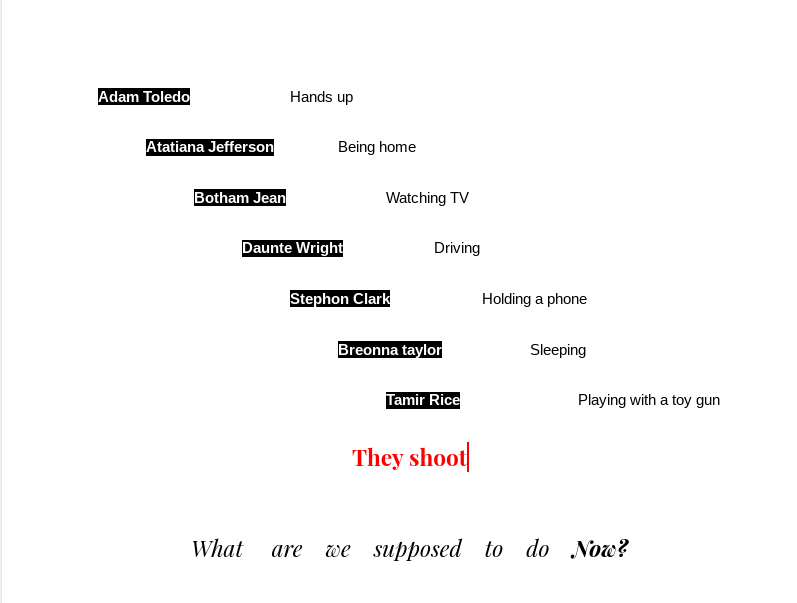Citizen: An American Lyric by Claudia Rankine is a lyric that describes the life black people in America. Rankine tells this story through a second person of view through the character “you”. Throughout the final chapter of the book, the protagonist questions her identity and self worth since society’s racism towards the black community constantly interferes with the way black people view themself as a full human being in America. However, at the end of the book, Rankine switches perspective to first person showing how the protagonist has embodied her true self instead of letting society impact how she views herself.
In the beginning of chapter 7, Rankine writes a non narrative poem with more conventional line breaks than usually. The protagonist has “some years…wanting to escape- floating above your certain ache- still the ache coexists.” (Rankine, 139) By explaining that escaping from the racism in society gives the protagonist headaches, we can infer that it is painful for the black people to constantly fight against racism. These headaches are a reminder of the emotional suffering that blacks constantly have to deal with. This emotional suffering is evident throughout the rest of Rankine’s poem as shown when “you” discovers that “given the histories of you and you” makes the protagonist question herself by asking “ who is this you” (Rankine, 140) and “How to care for the injured body, the kind of body that can’t hold the content it is living?” (Rankine, 143) When the protagonist asks these questions, it is evident that society views black people as worthless, which is caused by the long history of racism in the US.
On July 13, 2013, George Zimmerman was on trial for the murder of Trayvon Martin, which caused an uproar throughout the United States. While listening to the radio broadcast about Martin, the neighboring car next to the protagonist said something racist about Martin which led to the protagonist unleashing his anger. The protagonist knew that her “partner wants to face off with a mouth and who knows what handheld object the other vehicle carries. You pull your love back into the seat because though no one seems to be chasing you, the justice system has other plans.” (Rankine, 151) We can assume that the protagonist’s friend is black and the person in the neighboring car is white. The protagonist is trying to calm her friend down because she knows that rage and anger will put them at danger. You understand that the justice system has always been against black people. If a black person naturally shows their anger in public, the justice system will unfairly punish black people. Because of this, you doesn’t feel safe showing anger in public. The justice system is an example of how society treats black people. Society wants black people to get over racist encounters and racist history by reacting in a way that is seen as negative and threatening.
At the end of the book, Rankine switches to a first person point of view and tells the last final page of the story through the character “I”. I has an encounter with microaggression before she went to play tennis where “a woman pulled in and started to park her car” but when she noticed that I is black, “she backed up and parked on the other side of the lot.” I’s husband asked if she won from this microaggression but I knew that “it wasn’t a match…it was a lesson.” (Rankine, 159) In this event, a match is when a person is able to go up against another person implying that the standard for both are equal and fair. A lesson is defined to teach or instruct. This line connects to Rankine’s bigger idea of how to combat racism which is to educate those to show how racism affects people of color since white people can never experience the struggles that people of color face.
Work Cited:
Rankine, Claudia, 1963-author. Citizen : An American Lyric. Minneapolis, Minnesota : Graywolf Press, 2014.
Discussion Questions:
- How would you interpret the image on page 147?
- Why is the shift between second pov to first pov significant?

